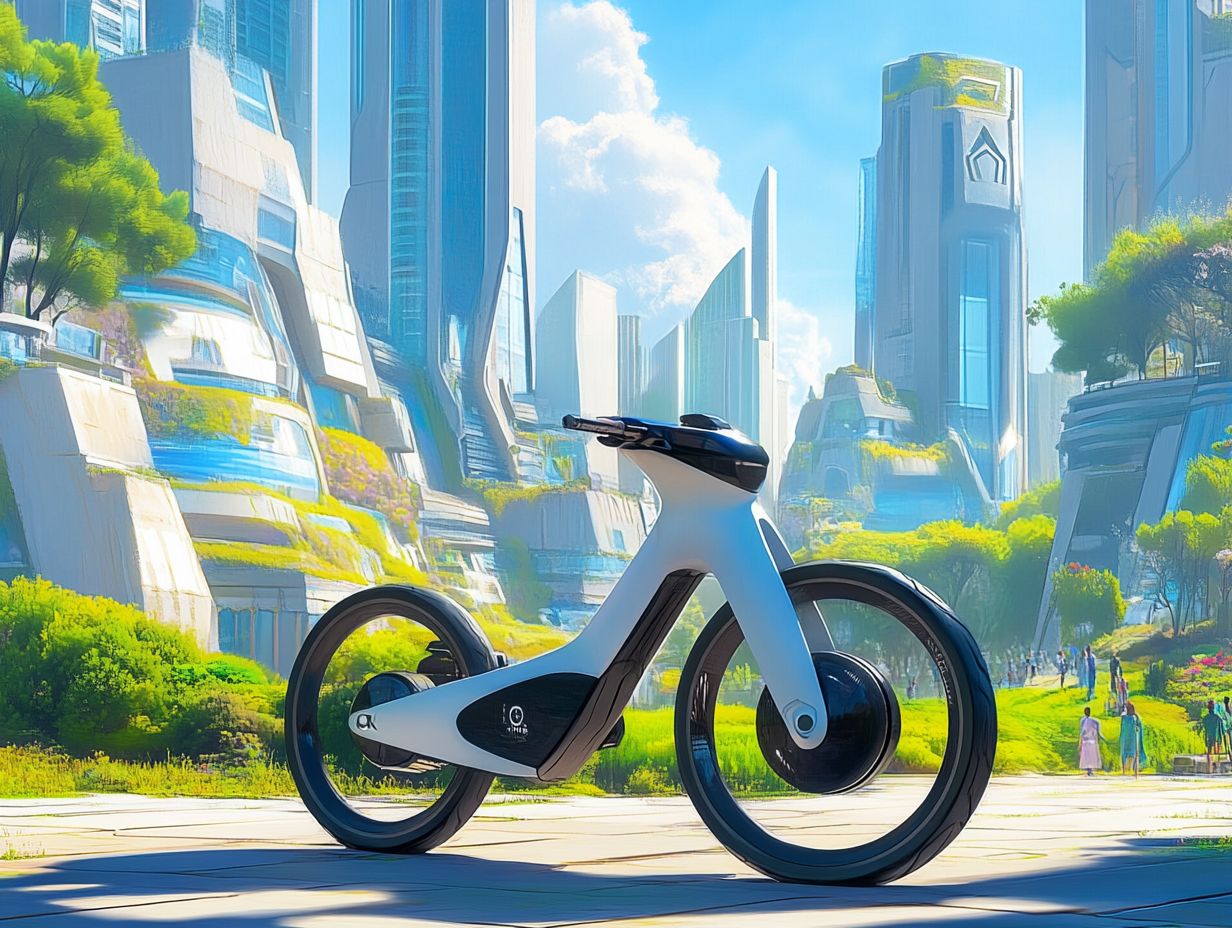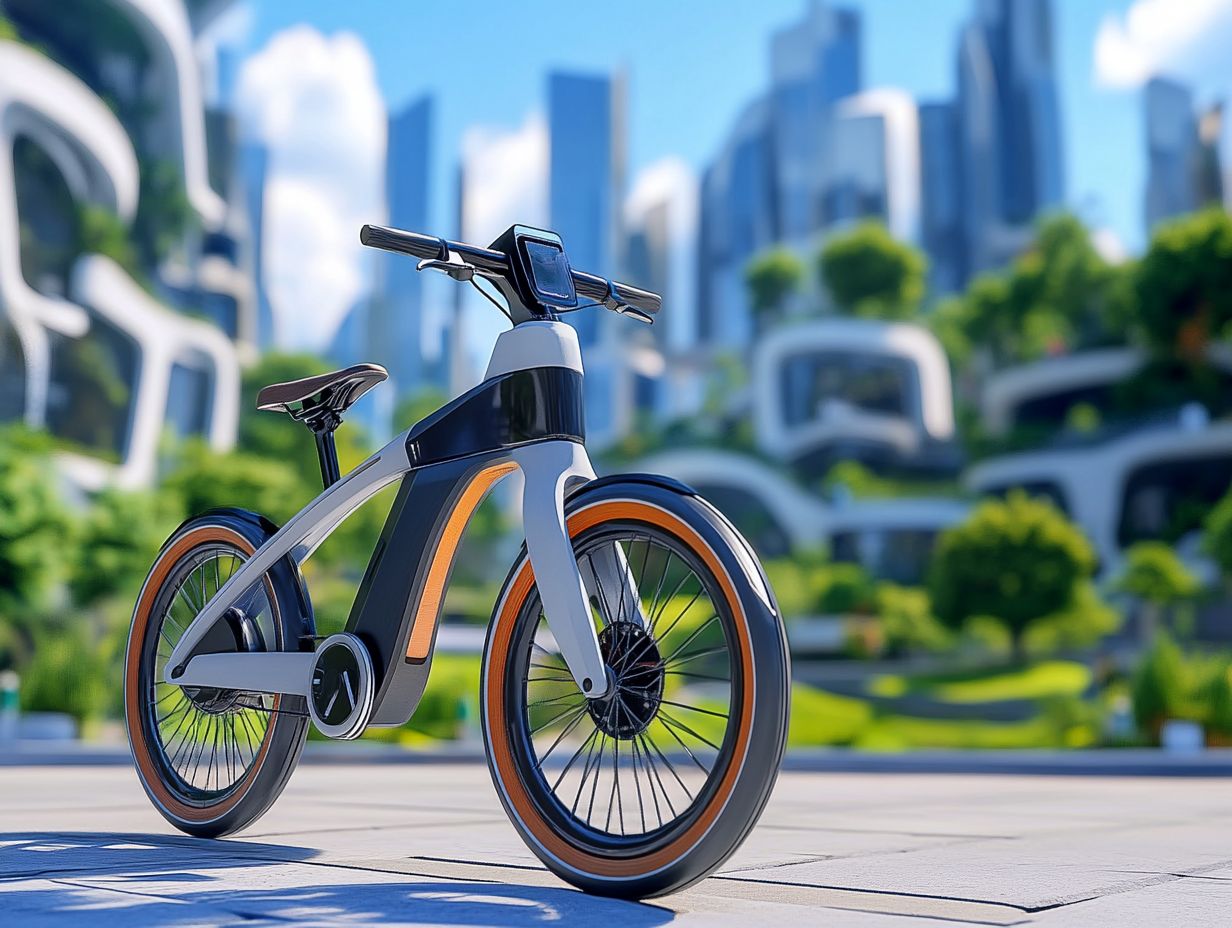What is the Future of Electric Bicycles?
Electric bicycles, or e-bikes, are revolutionizing your approach to transportation, seamlessly blending convenience, sustainability, and cutting-edge innovation.
This article delves into the current landscape of the e-bike market, showcasing trends in adoption and the latest technological breakthroughs. You ll discover the myriad benefits these electric bikes provide, from their positive environmental impact to their health advantages, while also confronting essential challenges like infrastructure and safety.
Predictions for the future are presented, offering you valuable insights into how electric bicycles might redefine urban mobility. Join us on this exciting journey into the world of electric bikes!
Contents
Key Takeaways:

- Electric bicycles are bicycles with an integrated electric motor that assists with pedaling, providing a smoother and easier riding experience.
- The current market trends show rapid growth and increased adoption rates for electric bicycles, with advancements in technology leading to new features and innovations.
- The future of electric bicycles looks promising, with expected growth and a positive impact on transportation, but challenges such as infrastructure and safety concerns need to be addressed.
What are Electric Bicycles?
Electric bicycles, or e-bikes as they are often called, represent a contemporary approach to transportation that harmoniously combines the charm of traditional cycling with cutting-edge battery technology. They offer an eco-friendly alternative for navigating urban landscapes.
With the global surge in e-bike markets, these electric wonders have gained remarkable popularity. Their lightweight designs effortlessly adapt to diverse terrains, from bustling city streets to expansive public lands. Consequently, e-MTBs (electric mountain bikes) and cargo e-bikes are rising in prominence, catering to a wide array of riders and their unique requirements, particularly in public lands. To understand how these changes came about, explore the evolution of electric bicycle types over time.
Current State of Electric Bicycles
The current landscape of electric bicycles is characterized by a remarkable surge in growth and innovation, driven by changes in transportation and rising adoption rates across various demographics.
Initiatives like the California E-Bike Incentive Project have sparked significant interest by highlighting safety features and promoting affordability. This makes e-bikes accessible to a wider audience through partnerships with organizations like USDOT and the Federal Highway Administration. This momentum represents a transformative shift in how cycling is viewed, now regarded as a practical option for both urban commuting and recreational enjoyment, particularly in urban environments. To learn more about the evolving landscape of the future of electric bicycle brands, explore the exciting developments in this sector.
Market Trends and Adoption Rates
The e-bike market is experiencing remarkable growth, with adoption rates skyrocketing in regions like Europe. Countries such as Germany, France, Netherlands, and Italy are at the forefront, enthusiastically integrating electric bicycles into their transportation systems.
This surge is driven by a perfect storm of factors, including rising consumer interest in sustainability and innovations like smart integration and Bluetooth connectivity. Consumers are increasingly drawn to sustainable transportation options, while significant technological advancements are boosting battery life and performance. For those interested in what’s next, exploring the trends in electric bicycle brands for 2024 reveals how supportive regulatory frameworks further incentivize e-bike use, creating a favorable environment for this burgeoning trend.
As urban mobility challenges intensify, these nations are not just investing in infrastructure to support e-bikes; they are also crafting policies that encourage a departure from traditional vehicles to promote lightweight e-bikes.
In this dynamic landscape, the focus on eco-friendly commuting solutions resonates deeply with a growing demographic eager to adopt innovative, efficient, and greener alternatives for their daily journeys.
Advancements in Electric Bicycle Technology

Advancements in electric bicycle technology are transforming your cycling experience in remarkable ways. Significant strides in battery technology and smart integration now offer unmatched performance and usability that will change how you ride!
Imagine riding a connected bike equipped with features that allow your bike to connect to the internet, where you can interact seamlessly with your e-bike using your smartphone. Features like real-time tracking, performance analytics, and personalized settings enhance your ride, making cycling more engaging and efficient than ever before.
New Features and Innovations
Recent innovations in electric bicycles have introduced new safety features and enhanced battery technology that elevate your riding experience. With the integration of smart technology that learns from your riding habits and Bluetooth connectivity, these advancements prioritize your comfort while enhancing your safety.
Features like collision detection systems and automatic brake adjustments make urban commuting significantly safer, allowing you to navigate the city with ease.
The battery systems have also undergone impressive upgrades, offering longer life spans and faster charging capabilities tailored to meet the demands of modern cyclists. Advanced AI technology can analyze your riding patterns in real time, optimizing performance according to the terrain and your behavior, ensuring that every journey is smoother and more efficient. To stay informed about these advancements and the future electric bicycle legislation, it’s important to keep an eye on emerging laws and regulations.
These developments signify a transformative shift in how you approach your daily rides, blending technology with traditional cycling in ways previously unimaginable, especially with the rise of innovation in cycling.
Why You Need an Electric Bicycle Today!
Electric bicycles present a wealth of advantages that go beyond mere convenience; they actively contribute to environmental sustainability while enhancing your health and wellness.
By reducing carbon emissions, e-bikes are crucial now more than ever in the fight for a sustainable future! They play a vital role in sustainability initiatives designed to transform urban commuting and help make our cities better for cyclists, exemplified by the rise of electric touring bicycles.
Environmental and Health Benefits
The environmental and health benefits of electric bicycles are truly remarkable. They allow you to reduce your reliance on fossil fuels while promoting physical activity and healthier lifestyles.
By incorporating e-bikes into your urban transportation routine, you contribute directly to lower greenhouse gas emissions, helping create cleaner and more sustainable cities. Cycling not only cuts down on pollution from traditional vehicles but also enhances air quality an essential factor for public health.
Regularly using electric bicycles encourages cardiovascular fitness and strengthens your muscles, boosting your overall well-being while promoting healthier lifestyles. As urban areas grow increasingly congested, embracing cycling as a legitimate commuting option can ease traffic woes and reduce wear and tear on roadways. Additionally, advancements in the future of electric bicycle innovation are making these options even more appealing. This shift creates a more efficient and enjoyable environment for everyone.
Challenges and Concerns for the Future

Despite the many advantages of electric bicycles, several challenges and concerns cast a shadow over their future. These primarily revolve around infrastructure and safety issues that need to be addressed to foster widespread acceptance and usage of electric bicycles.
The existing regulatory framework governing e-bikes varies considerably from one area to another, impacting trail access and potentially creating barriers that could stifle the growth of e-bike popularity across different regions. As technology advances, exploring the future of electric bicycle maintenance technologies can help address some of these challenges.
Infrastructure and Safety Concerns
Infrastructure and safety concerns are pivotal issues for the e-bike community. When facilities fall short, they can deter potential riders. Additionally, the existing regulatory frameworks often lack sufficient protections for them.
Developing dedicated bike lanes is crucial for creating a safe space for riders. Thoughtfully designed parking solutions and strategically placed charging stations can significantly enhance the e-bike experience, making it a more appealing choice for commuters. Moreover, as we look ahead, understanding the growth of electric bicycle brands in 2024 will provide valuable insights into the evolution of this transportation option.
Integrating safety features like reflective signage and well-lit pathways helps improve visibility and prevent accidents, enhancing trail access for riders. As public lands increasingly welcome e-bike usage, understanding these trends and addressing safety measures fosters a more inclusive cycling culture, inspiring more individuals to adopt this eco-friendly mode of transportation.
Predictions for the Future of Electric Bicycles
Exciting times are ahead for electric bicycles with an impressive surge in the e-bike market. They are expected to become essential to the evolution of transportation systems worldwide.
As smart features improve your riding experience, e-bikes are set to transform urban commuting landscapes.
Expected Growth and Impact on Transportation
The anticipated growth in the e-bike market is set to profoundly impact transportation systems. E-bikes are emerging as pivotal players in urban commuting and sustainable transit solutions, which are ways to travel that benefit the environment.
As more cities recognize the advantages of integrating this innovative cycling option into their infrastructure, a noticeable shift in commuting patterns is expected. Urban planners and policymakers are likely to prioritize dedicated bike lanes and rental programs. For insights on how these changes might evolve, check out the future of electric bicycle legislation, making cycling more accessible and appealing to everyone.
This evolution could alleviate traffic congestion, reduce carbon emissions, and promote healthier lifestyles for all. Furthermore, collaboration between technology firms and local governments is set to bring advanced features to e-bikes, including smart navigation and enhanced safety measures. As we look ahead, understanding the future of electric bicycle types in 2024 will be essential for further improving urban transport dynamics.
Frequently Asked Questions

What is the future of electric bicycles?
The future of electric bicycles looks promising as more people turn to eco-friendly transportation options. Advances in technology are making electric bicycles more efficient, affordable, and accessible to everyone.
How will electric bicycles impact the environment?
Electric bicycles are a greener alternative to traditional transportation modes like cars and motorcycles. They help reduce carbon emissions, improve air quality, and combat climate change.
Will electric bicycles replace traditional bicycles?
While electric bicycles are gaining popularity, they won t completely replace traditional bikes. Each has unique advantages, depending on individual preferences and needs.
What are the benefits of using an electric bicycle?
Benefits of using an electric bicycle include reducing carbon emissions, saving on transportation costs, and improving physical fitness. They also provide a more enjoyable and efficient way to commute.
Are there any downsides to electric bicycles?
Like any form of transportation, electric bicycles have downsides, such as the initial purchasing cost and the need to recharge the battery. However, these downsides are outweighed by the numerous benefits.
How can electric bicycles be incorporated into cities?
Many cities are implementing bike-sharing programs and creating designated bike lanes for electric bicycles. As their popularity grows, we can expect more cities to promote bike-friendly and eco-friendly transportation options.






